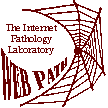|
A 54-year-old man has been experiencing recurrent burning epigastric pain for about 12 weeks. The pain lessens after meals but worsens 3-4 hours after each meal. Although the pain often awakens him during night, the man has not sought medical advice because he is a workaholic and feels that he cannot afford to take time off from his job. Besides, OTC antacid tablets seem to at least partially relieve the pain. Then, one evening, he develops diffuse abdominal pain and vomiting after eating his dinner. The pain persists through the night and worsens the next morning. Pain and intermittent vomiting continue throughout the day and the following night, and he develops a fever. Moreover, the pain worsens during this period. By the next morning, he feels really sick and finally goes to the emergency room at the local hospital. His vital signs are: T = 38.5 C, P = 105, R = 24, BP = 105/65 mm Hg. The chest and heart examinations are normal. The abdomen is somewhat distended and there is a diffuse tenderness to palpation with guarding. No herniations are noted. Bowel sounds are absent. The man has no history of use of prescription medications, drug or alcohol abuse, trauma, surgery, or infections. He has had to prior surgeries.
Question 8.1: What is your preliminary diagnosis?
The patient's history and current symptoms point to a possible case of peritonitis, a potentially very dangerous situation. The differential includes appendicitis, inflammatory bowel disease (IBD), infectious colitis, diverticulitis, acute cholecystitis, pancreatitis, bowel obstruction, etc.
Question 8.2: What tests should you do?
If peritonitis is suspected, an abdominal X-ray series (to look for free air, bowel distention, etc.) and a chest X-ray (to detect an elevated diaphragm) should be done immediately, along with a CBC with differential. If readily available, an abdominal CT scan could also be helpful.
To further substantiate the diagnosis and/or to eliminate differential diagnoses, additional tests might include SMA7 (electrolyte imbalances, kidney dysfunction), amylase (pancreatitis), LFT (liver disease, cholelithsiasis), blood cultures (bacteremia, sepsis), paracentesis with ascitic fluid analysis (transudate versus exudate), etc.
Test Results
The hematocrit was 45% and the white blood cell count was 24,000/microliter, with 80% PMNs, 10% bands, and 10% lymphocytes. Serum amylase, electrolytes, and tests of liver and renal function were all normal. However, the X-rays reveal several distended bowel loops and the presence of free air below the diaphragm on the left.
Question 8.3: What do you do next?
The x-ray findings strongly support the diagnosis of peritonitis and indicate the emergency surgery should be performed to investigate and correct the problem. In this case, surgery revealed that the patient had a duodenal ulcer that perforated, allowing contents of the intestinal lumen to spill out into the peritoneal cavity. This led to an acute inflammation of the peritoneum that, in turn, produced most of the patient's recent symptoms.
Question 8.4: Which microbes are most often associated with this condition?
Peritonitis is usually a mixed infection because it occurs when the normal microbial flora of the GI tract (a diverse group of microorganisms) spills into the peritoneal cavity. In some cases, the perforation of the bowel wall is caused by an invasive pathogenic microbe (although that did not happen in the case presented here). Even then, the peritoneal inflammation will result more from the relatively large numbers of intestinal microbes present than from the actions of the pathogen. Among the microbes that are most often associated with peritonitis are Escherichia coli, Klebsiella pneumoniae, other Enterobacteriaceae, Enterococcus, Bacteroides fragilis and other species, Fusobacterium species, Clostridium species, Peptostreptococcus species, and several others.
Question 8.5: How should this case be treated?
The perforated bowel is, of course, repaired during surgery. Any contaminated abscess fluid is evacuated and, if necessary, drains are placed and monitored. Broad-spectrum antibiotics are administered to kill off any remaining infectious bacteria. Typical antibiotic regimens might be as follows:
* Single agent: ceftrioxone (1-2 g IV q24h), cefotaxime (1-2 g IV q4-6h)
* Multiple agents:
a. Ampicillin (2 g IV q4-6h); gentamicin (1.5 mg/kg/day); clindamycin (600-900 mg IV q8h)
b. Ampicillin (2 g IV q4-6h); gentamicin (1.5 mg/kg/day); metronidazole (600 mg IV q6-8h)
|



